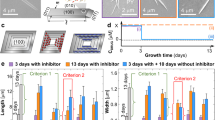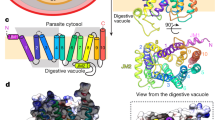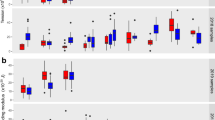Abstract
Despite the worldwide public health impact of malaria, neither the mechanism by which the Plasmodium parasite detoxifies and sequesters haem, nor the action of current antimalarial drugs is well understood. The haem groups released from the digestion of the haemoglobin of infected red blood cells are aggregated into an insoluble material called haemozoin or malaria pigment. Synthetic β-haematin (FeIII-protoporphyrin-IX)2 is chemically1,2, spectroscopically2,3 and crystallographically4 identical to haemozoin and is believed to consist of strands of FeIII-porphyrin units, linked into a polymer by propionate oxygen-iron bonds. Here we report the crystal structure of β-haematin determined using simulated annealing techniques to analyse powder diffraction data obtained with synchrotron radiation. The molecules are linked into dimers through reciprocal iron–carboxylate bonds to one of the propionic side chains of each porphyrin, and the dimers form chains linked by hydrogen bonds in the crystal. This result has implications for understanding the action of current antimalarial drugs and possibly for the design of new therapeutic agents.
This is a preview of subscription content, access via your institution
Access options
Subscribe to this journal
Receive 51 print issues and online access
$199.00 per year
only $3.90 per issue
Buy this article
- Purchase on Springer Link
- Instant access to full article PDF
Prices may be subject to local taxes which are calculated during checkout




Similar content being viewed by others
References
Fitch, C. D. & Kanjananggulpan, P. The state of ferriprotoporphyrin IX in malaria pigment. J. Biol. Chem. 262, 15552–15555 (1987).
Slater, A. F. G. et al. An iron–carboxylate bond links the heme units of malaria pigment. Proc. Natl Acad. Sci. USA 88, 325–329 (1991).
Bohle, D. S. et al. Structural and spectroscopic studies of β-hematin (the heme coordination polymer in malaria pigment. Am. Chem. Soc. Symp. Ser. 572, 497–515 ( 1994).
Bohle, D. S., Dinnebier, R. E., Madsen, S. K. & Stephens, P. W. Characterization of the products of the heme detoxification pathway in malarial late trophozoites by X-ray diffraction. J. Biol. Chem. 272, 713–716 (1997).
Olliaro, P. L. & Goldberg, D. E. The plasmodium digestive vacuole- metabolic headquarters and choice drug target. Parasitol. Today 11, 294–297 ( 1995).
Yayon, A., Cabantchik, I. & Ginsburg, H. Susceptibility of human malaria parasites to chloroquine is pH dependent. Proc. Natl Acad. Sci. USA 82, 2784–2788 (1985).
Homewood, C., Warhurst, D., Peters, W. & Baggaley, V. Lysosomes, pH and the anti-malarial action of chloroquine. Nature 235, 50–52 (1972).
Slater, A. F. G. & Cerami, A. Inhibition by chloroquine of a novel haem polymerase enzyme activity in malaria trophozoites. Nature 355, 167–169 ( 1992).
Dorn, A., Stoffel, R., Matile, H., Bubendorf, A. & Ridley, R. G. Malarial haemozoin/β-haematin supports haem polymerization in the absence of protein. Nature 374 , 269–271 (1995).
Sullivan, D. J., Gluzman, I. Y., Russell, D. G. & Goldberg, D. E. On the molecular mechanism of chloroquine's antimalarial action. Proc. Natl Acad. Sci. USA 93, 11865– 11870 (1996).
Bohle, D. S., Debrunner, P., Jordan, P. A., Madsen, S. K. & Schulz, C. E. Aggregated heme detoxification byproducts in malarial trophozoites: β-hematin and malaria pigment have a single S = 5/2 iron environment in the bulk phase as determined by EPR and magnetic Mössbauer spectroscopy. J. Am. Chem. Soc. 120, 8255–8256 (1998).
Adams, P. A., Berman, P. A. M., Egan, T. J., Marsh, P. J. & Silver, J. The iron environment in heme and heme-antimalarial complexes of pharmacological interest. J. Inorg. Biochem. 63, 69–77 ( 1996).
Dorn, A. et al. An assessment of drug–haematin binding as a mechanism for inhibition of haematin polymerisation by quinoline antimalarials. Biochem. Pharmacol. 55, 727–736 (1998).
Bendrat, K., Berger, B. J. & Cerami, A. Haem polymerization in malaria. Nature 378, 138 (1995).
Ridley, R. G., Dorn, A., Matile, H. & Kansy, M. Haem polymerization in malaria. Nature 378, 138– 139 (1995).
Francis, S. E., Sullivan, D. J. & Goldberg, D. E. Hemoglobin metabolism in the malaria parasite Plasmodium falciparum. Annu. Rev. Microbiol. 51 , 97–123 (1997).
Bohle, D. S. & Helms, J. B. Synthesis of beta-hematin by dehydrohalogenation of hemin. Biochem. Biophys. Res. Commun. 193, 504–508 (1993).
David, W. I. F., Shankland, K. & Shankland, N. Routine determination of molecular crystal structures from powder diffraction data. Chem. Commun. 931– 932 (1998).
Andreev, Y. G. & Bruce, P. G. Solving crystal structures of molecular solids without single crystals: a simulated annealing approach. J. Chem. Soc. Dalton Trans. 4071–4080 (1998).
Koenig, D. F. The structure of α-chlorohemin. Acta Crystallogr. 18, 663–673 (1965).
LeBail, A., Duroy, H. & Fourquest, J. L. Ab initio structure determination of LiSbWO 6 by X-ray-powder diffraction. Mater. Res. Bull. 23, 447–452 (1988).
Larson, A. C. & Von Dreele, R. B. GSAS General Structure Analysis System (Los Alamos Laboratory Report No. LA-UR-86-748, Los Alamos, 1987).
Bominaar, E. L. et al. Structural, Mossbauer, and EPR investigations on two oxidation states of a five-coordinate, high spin synthetic heme. Quantitative interpretation of zero-field parameters and large quadrupole splitting. Inorg. Chem. 31, 1845–1854 ( 1992).
Scheidt, W. R. & Lee, Y. J. Recent advances in the stereochemistry of metallotetrapyrroles. Struct. Bond. 64, 1–70 (1987).
Lemberg, R. & Legge, J. W. Haematin Compounds and Bile Pigments (Interscience, New York, 1949).
Sullivan, D. J., Matile, H., Ridley, R. G. & Goldberg, D. E. A common mechanism for blockade of heme polymerization by antimalarial quinolines. J. Biol. Chem. 273, 31103– 31107 (1998).
Slater, A. F. G. Chloroquine-mechanism of drug-action and resistance in Plasmodium falciparum . Pharm. Ther. 57, 203– 235 (1993).
Egan, T. J., Hempelmann, E. & Mavuso, W. W. Characterisation of synthetic beta-haematin and effects of the antimalarial drugs quinidine, halofantrine, desbutylhalofantrine and mefloquine on its formation. J. Inorg. Biochem. 73, 101–107 (1999).
Gluzman, I. Y. et al. Order and specificity of the Plasmodium falciparum hemoglobin degradation pathway. J. Clin. Invest. 93 , 1602–1608 (1994).
Francis, S. E., Gluzman, I. Y., Oksman, A., Banerjee, D. & Goldberg, D. E. Characterization of native falcipain, an enzyme involved in Plasmodium falciparum hemoglobin degradation. Mol. Biochem. Parasitol. 83, 189– 200 (1996).
Acknowledgements
The National Synchrotron Light Source, Brookhaven National Laboratory, is supported by the US Department of Energy, Division of Chemical Sciences and Division of Materials Sciences. D.S.B. acknowledges financial support from Dreyfus Foundation and the United Nations Development Programs/World Bank/World Health Organisation Special Programme for Research and Training in Tropical Diseases. The SUNY X3 beamline at the National Synchrotron Light Source is supported by the Division of Basic Energy Sciences of the US Department of Energy.
Author information
Authors and Affiliations
Corresponding author
Supplementary information
41586_2000_BF35005132_MOESM1_ESM.doc
(a) atomic positions after the Rietveld refinement, (b) selected interatomic distances and (c) selected interatomic angles.
Rights and permissions
About this article
Cite this article
Pagola, S., Stephens, P., Bohle, D. et al. The structure of malaria pigment β-haematin. Nature 404, 307–310 (2000). https://doi.org/10.1038/35005132
Received:
Accepted:
Issue Date:
DOI: https://doi.org/10.1038/35005132
This article is cited by
-
Epigenetic and transcriptional regulation of cytokine production by Plasmodium falciparum-exposed monocytes
Scientific Reports (2024)
-
Identification and characterisation of the haemozoin of Haemonchus contortus
Parasites & Vectors (2023)
-
Identifying inhibitors of β-haematin formation with activity against chloroquine-resistant Plasmodium falciparum malaria parasites via virtual screening approaches
Scientific Reports (2023)
-
Nonclassical mechanisms to irreversibly suppress β-hematin crystal growth
Communications Biology (2023)
-
Hemozoin in malaria eradication—from material science, technology to field test
NPG Asia Materials (2023)
Comments
By submitting a comment you agree to abide by our Terms and Community Guidelines. If you find something abusive or that does not comply with our terms or guidelines please flag it as inappropriate.



